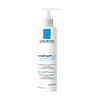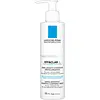La Roche-Posay Cicaplast Lavant B5 Purifying Soothing Foaming Gel Versus La Roche-Posay Effaclar H Hydrating Cleansing Cream
What's inside
What's inside
 Key Ingredients
Key Ingredients

 Benefits
Benefits

 Concerns
Concerns

 Ingredients Side-by-side
Ingredients Side-by-side

Water
Skin ConditioningSodium Laureth Sulfate
CleansingPanthenol
Skin ConditioningPEG-200 Hydrogenated Glyceryl Palmate
CleansingGlycerin
HumectantCoco-Betaine
CleansingSodium Chloride
MaskingPolysorbate 20
EmulsifyingPEG-7 Glyceryl Cocoate
EmulsifyingCitric Acid
BufferingCocamide Mea
EmulsifyingCopper Gluconate
Skin ConditioningManganese Gluconate
Skin ConditioningPEG-55 Propylene Glycol Oleate
PEG-60 Hydrogenated Castor Oil
EmulsifyingPolyquaternium-11
PPG-5-Ceteth-20
EmulsifyingPropylene Glycol
HumectantPrunus Amygdalus Dulcis Oil
Skin ConditioningSodium Benzoate
MaskingSodium Hydroxide
BufferingZinc Gluconate
Skin ConditioningWater, Sodium Laureth Sulfate, Panthenol, PEG-200 Hydrogenated Glyceryl Palmate, Glycerin, Coco-Betaine, Sodium Chloride, Polysorbate 20, PEG-7 Glyceryl Cocoate, Citric Acid, Cocamide Mea, Copper Gluconate, Manganese Gluconate, PEG-55 Propylene Glycol Oleate, PEG-60 Hydrogenated Castor Oil, Polyquaternium-11, PPG-5-Ceteth-20, Propylene Glycol, Prunus Amygdalus Dulcis Oil, Sodium Benzoate, Sodium Hydroxide, Zinc Gluconate
 Reviews
Reviews

Ingredients Explained
These ingredients are found in both products.
Ingredients higher up in an ingredient list are typically present in a larger amount.
Glycerin is already naturally found in your skin. It helps moisturize and protect your skin.
A study from 2016 found glycerin to be more effective as a humectant than AHAs and hyaluronic acid.
As a humectant, it helps the skin stay hydrated by pulling moisture to your skin. The low molecular weight of glycerin allows it to pull moisture into the deeper layers of your skin.
Hydrated skin improves your skin barrier; Your skin barrier helps protect against irritants and bacteria.
Glycerin has also been found to have antimicrobial and antiviral properties. Due to these properties, glycerin is often used in wound and burn treatments.
In cosmetics, glycerin is usually derived from plants such as soybean or palm. However, it can also be sourced from animals, such as tallow or animal fat.
This ingredient is organic, colorless, odorless, and non-toxic.
Glycerin is the name for this ingredient in American English. British English uses Glycerol/Glycerine.
Learn more about GlycerinSodium Hydroxide is also known as lye or caustic soda. It is used to adjust the pH of products; many ingredients require a specific pH to be effective.
In small amounts, sodium hydroxide is considered safe to use. However, large amounts may cause chemical burns due to its high alkaline.
Your skin has a natural pH and acid mantle. This acid mantle helps prevent harmful bacteria from breaking through. The acid mantle also helps keep your skin hydrated.
"Alkaline" refers to a high pH level. A low pH level would be considered acidic.
Learn more about Sodium HydroxideSodium Laureth Sulfate (SLES) is a foaming, cleansing, and emulsifying ingredient. It is created from palm kernel oil or coconut oil. SLES is not the same as sodium lauryl sulfate. It is much milder and less likely to irritate.
SLES helps create foam in personal products. It also prevents ingredients from separating, helping to elongate the shelf life.
Sodium Laureth Sulfate is a type of sulfate. It can be drying. We recommend speaking with a professional about using this ingredient if you have concerns.
Learn more about Sodium Laureth SulfateWater. It's the most common cosmetic ingredient of all. You'll usually see it at the top of ingredient lists, meaning that it makes up the largest part of the product.
So why is it so popular? Water most often acts as a solvent - this means that it helps dissolve other ingredients into the formulation.
You'll also recognize water as that liquid we all need to stay alive. If you see this, drink a glass of water. Stay hydrated!
Learn more about Water